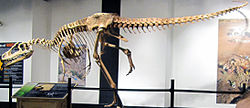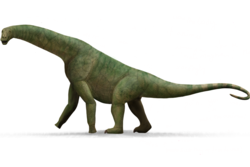This biography of a living person includes a list of references, related reading, or external links, but its sources remain unclear because it lacks inline citations .(February 2015) |
Jeffrey A. Wilson, also known as JAW, is a paleontologist and professor of geological sciences and assistant curator at the Museum of Paleontology at the University of Michigan.
His doctoral dissertation was on sauropod evolution and phylogeny, and he has continued this work in cladistic analysis and revision of the group (see e.g. Wilson and Sereno 1994, 1998, Wilson 2005b, and especially Wilson 2002). With Paul Sereno, he defined the clades Macronaria and Somphospondyli (Wilson & Sereno 1998).
Wilson was also involved in the discovery and description of Pabwehshi pakistanensis , the first discovery of decent (diagnostic) Cretaceous crocodylian fossil remains from the Indian subcontinent, in the discovery of Rajasaurus narmadensis , the most completely known theropod dinosaur from India and a member of the family Abelisauridae, description of a number of North African dinosaurs (theropods and sauropods) from Niger, and rediscriptions of the Cretaceous sauropods Titanosaurus colberti (as Isisaurus ) and Nemegtosaurus (previously thought to be a diplodocoid, but now recognised as a titanosaur).
His younger brother, Dr. Gregory P. Wilson, studies Mesozoic mammals and is currently an assistant professor in the Department of Biology at the University of Washington, and adjunct curator of vertebrate paleontology at the Burke Museum of Natural History and Culture.




